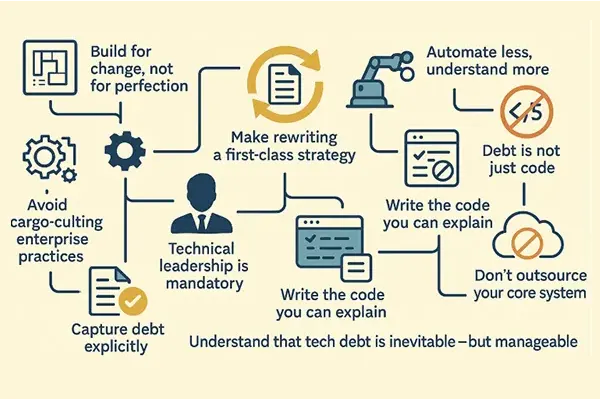
How to Avoid Early-Stage Tech Debt
In the early days of a startup, speed is everything. Getting a working product to market quickly often feels like the only priority that matters. Founders race against time and funding, building fast, cutting corners, and stacking features to satisfy users or investors. And while this velocity may win you early traction, it can silently lay the foundation for a trap: early-stage technical debt.
How to Avoid Early-Stage Tech Debt
In the early days of a startup, speed is everything. Getting a working product to market quickly often feels like the only priority that matters. Founders race against time and funding, building fast, cutting corners, and stacking features to satisfy users or investors. And while this velocity may win you early traction, it can silently lay the foundation for a trap: early-stage technical debt.
Technical debt is not inherently bad. Like financial debt, it can be a strategic decision. The problem is when it goes unrecognized, or worse, unacknowledged. At that point, it quietly compounds, and before you know it, even the smallest changes become slow, costly, or risky. In extreme cases, it can threaten the entire product roadmap or company viability.
But tech debt is not inevitable. It can be minimized, controlled, and even weaponized—if handled with foresight and discipline. Here’s how.
Here's the cheat sheet to help you avoid early-stage tech debt:

Let us now discuss the key strategies to avoid early-stage tech debt in more detail.
Build for Change, Not for Perfection
The worst kind of tech debt isn’t messy code. It’s rigid architecture. In the early stage, it’s tempting to over-engineer systems with the idea that they’ll be “future-proof.” You’ll design abstraction layers, plugin systems, or elaborate microservices before you’ve proven the product has users.
Don’t.
Instead, design for flexibility, not scale. Focus on simplicity. Use a modular monolith instead of premature service decomposition. Choose tools and patterns that allow for easy refactoring, not ones that try to anticipate every possible future scenario. Your product will change dramatically in the first year. Your architecture should allow that—not resist it.
Avoid Cargo-Culting Enterprise Practices
Startups sometimes mimic large companies by introducing complex patterns, frameworks, or DevOps processes far too early. They implement CI/CD pipelines with dozens of gates, logging systems designed for distributed clusters, and DDD architectures when they don’t even have two developers.
That’s not technical maturity—it’s waste.
Big companies operate under different constraints: compliance, thousands of deployments, legacy systems, massive teams. You don’t. If you’re a three-person team using Kubernetes and Kafka from day one, ask yourself: Why? Is the complexity solving a real problem, or is it a misguided attempt to appear “serious”?
Adopt tools that help you move faster today, not ones that make you look enterprise-ready tomorrow.
Make Rewriting a First-Class Strategy
There’s a quiet taboo in engineering: rewrites are bad. You’re supposed to keep building on top of what you have, even if it’s ugly. But early-stage products are prototypes, and prototypes should be rewritten.
Plan for this. It’s often faster to rewrite a well-understood module than to keep bending it into something it was never meant to be. The key is modularization. If your codebase is well-scoped, you can afford to throw out one module without affecting the others. This gives you agility without fear.
Some of the best engineering teams rebuild critical components every 6–12 months in the early stages. It’s not waste. It’s evolution.
Automate Less, Understand More
Automation feels like a responsible engineering decision. You want tests, CI, code quality checks, build scripts, and infrastructure-as-code. But early on, too much automation becomes a distraction.
Don’t automate things you don’t understand. A flaky test suite or over-complicated deploy pipeline adds more debt than it solves. Focus instead on observability and manual traceability. Understand your product intimately before trying to automate it.
Then automate incrementally, only when it’s clear what you’re automating and why.
Debt Is Not Just Code
Tech debt often hides in places that don’t look technical:
- Ambiguous requirements that are implemented poorly and later have to be reworked.
- Poorly defined domains that lead to sprawling, inconsistent models.
- Lack of documentation, which makes onboarding new developers an exercise in archaeology.
- Quick hacks in infrastructure or security that later become hard requirements.
These aren’t bugs. They’re design flaws. And if you don’t spot them early, they metastasize into systems that are hard to evolve.
Treat decisions as debt, not just implementations. When you compromise on a model, a boundary, or a protocol—track it, and revisit it regularly.
Technical Leadership Is Mandatory, Even in Small Teams
A common trap is the idea that a startup doesn’t need a CTO or tech lead in the early phase—that everyone can just code. But someone must own the architecture and quality. If no one does, tech debt is guaranteed.
Technical leadership doesn’t mean setting up review boards and architecture councils. It means having someone who makes tradeoffs visible, keeps track of shortcuts, and ensures that the team doesn’t break things faster than they can fix them.
This person doesn’t just write code. They own the system’s long-term health, and they act as the conscience of the codebase.
Write the Code You Can Explain
Early-stage products are not the place for cleverness. They’re the place for clarity.
Write code your teammates can understand without asking you. Prefer explicitness over elegance. Avoid obscure patterns unless they solve a real, current problem. When someone reads your code, they should say, “Ah, of course,” not “What the hell is this?”
This isn’t about lowering the bar—it’s about increasing resilience. Code that’s easy to reason about is code that’s easy to debug, extend, and rewrite. In the early days, that’s worth more than any performance gain.
Capture Debt Explicitly
Most teams know they’re cutting corners. But they don’t track those decisions.
Start early. Use a simple file, tag system, or issue tracker to log:
- What shortcut was taken
- Why it was done
- When it should be revisited
- What the impact could be if it lingers too long
You don’t need a fancy system—just intentionality. When technical debt becomes a known, traceable entity, it loses its power. You can prioritize it like any other task.
The danger lies in the unknown debt—the things no one remembers or understands anymore.
Don’t Outsource Your Core System
Another early-stage trap: outsourcing or using no-code tools for the parts of your product that define your business. It might save time now, but it builds dependency debt.
If your core workflow lives in someone else’s black box, you’ll hit a wall when you need customization, optimization, or scale. Worse, you may be locked into pricing or performance you can’t control.
Use external services where they don’t constrain you. But own your product’s nervous system. You’ll pay for it either way—so better now than later.
Understand That Tech Debt Is Inevitable—But Manageable
You will have tech debt. That’s not failure. That’s just startup physics. The trick is not to eliminate it but to make sure it pays dividends. A shortcut that gets you real feedback is worth it. A shortcut no one remembers is a liability.
Treat tech debt like a loan: track it, budget for it, and pay it back when it matters. If you do that, you can move fast without breaking your future.
Because in the end, speed only helps if you’re still in control of the wheel.
Ready to Scale Your Software Architecture?
Let's discuss how we can help you build scalable, maintainable software that grows with your business and delivers measurable ROI.
Or reach us at: info@sharplogica.com